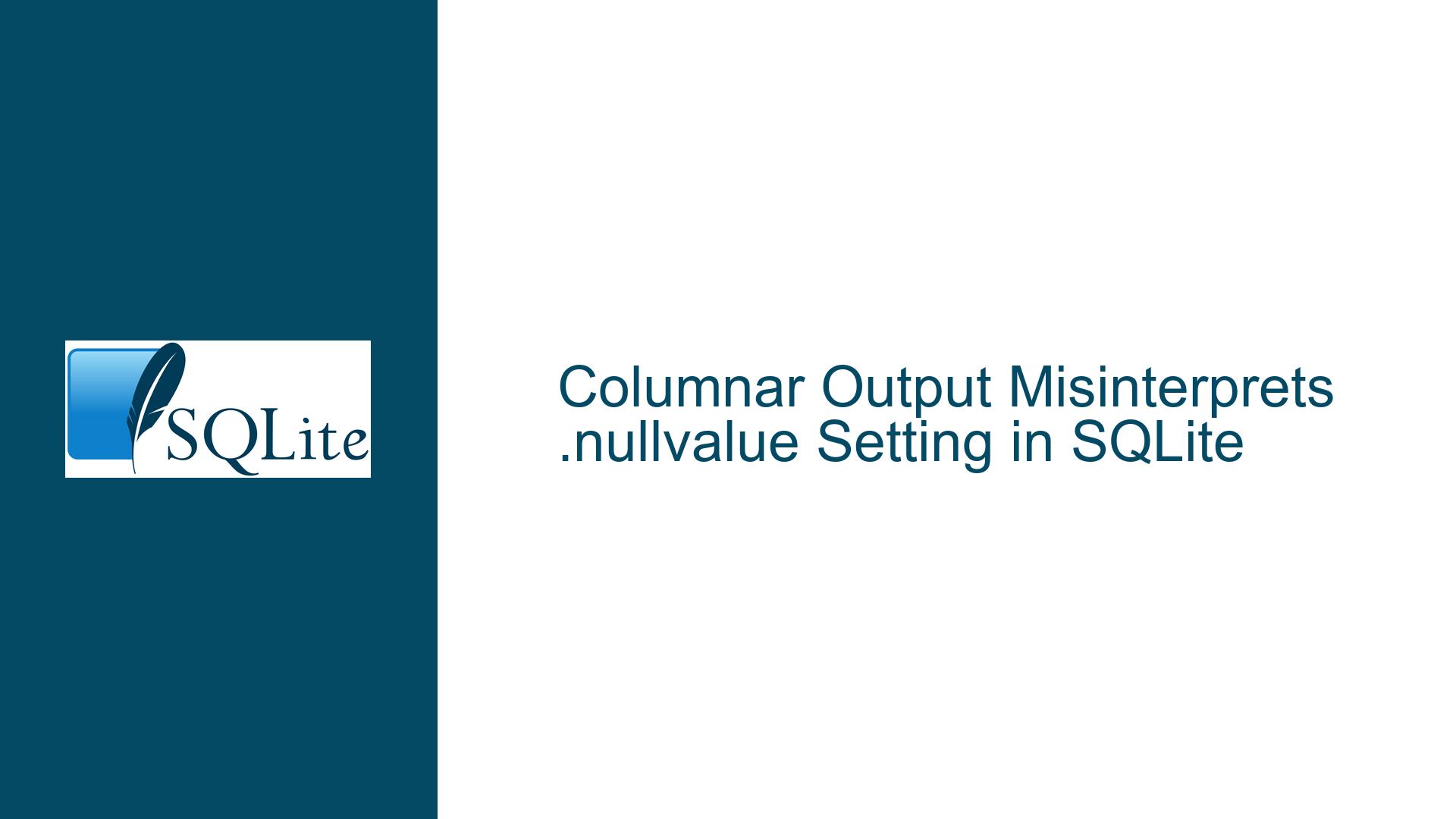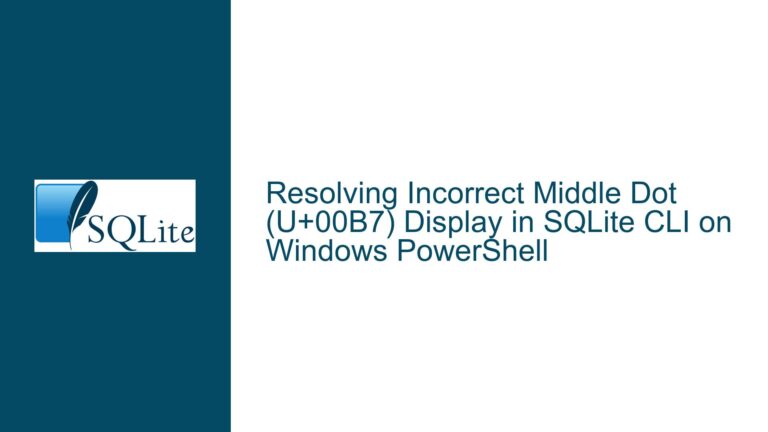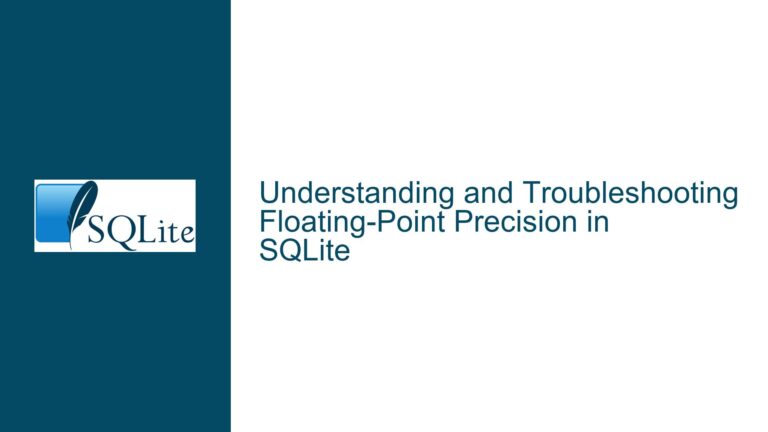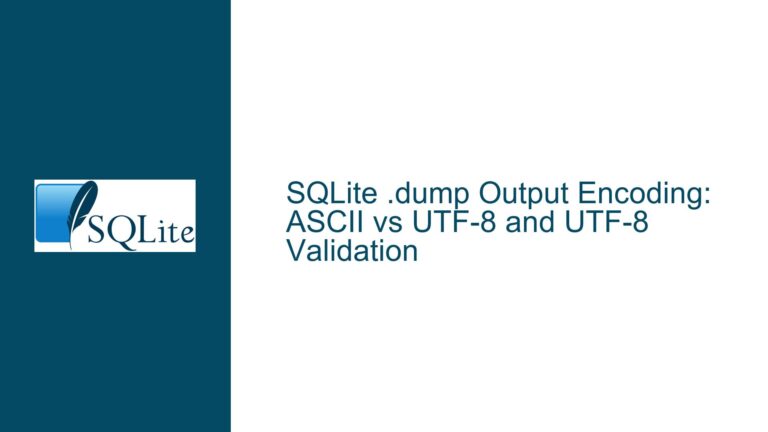Columnar Output Misinterprets .nullvalue Setting in SQLite
Columnar Output Misalignment Due to .nullvalue Configuration
The issue at hand revolves around the unexpected behavior of SQLite’s columnar output mode when the .nullvalue setting is configured to a non-default value, specifically NULL. This behavior manifests when querying a table with long text strings and NULL values, resulting in misaligned and confusing output. The problem arises because the columnar output mode internally uses the string NULL as a placeholder, which conflicts with the .nullvalue setting when it is explicitly set to NULL. This conflict causes the output to misinterpret the placeholder as an actual NULL value, leading to incorrect formatting and display.
The core of the issue lies in the interaction between the .nullvalue setting and the internal mechanisms of the columnar output mode. The .nullvalue setting is designed to replace NULL values in the output with a user-defined string, which can be useful for distinguishing NULLs from empty strings or other placeholders. However, the columnar output mode assumes that .nullvalue is set to an empty string or a non-conflicting value, leading to unexpected behavior when this assumption is violated.
Internal Use of NULL as a Placeholder in Columnar Mode
The columnar output mode in SQLite is designed to format query results in a tabular, column-aligned manner, which is particularly useful for readability when dealing with wide tables or long text strings. To achieve this alignment, the mode uses internal placeholders to represent NULL values during the formatting process. These placeholders are typically strings that are unlikely to appear in the actual data, such as NULL. However, this design choice creates a conflict when the .nullvalue setting is explicitly set to NULL, as the placeholder and the configured NULL representation become indistinguishable.
This conflict leads to the observed misalignment in the output. When the columnar mode encounters a NULL value, it replaces it with the internal placeholder NULL. However, because .nullvalue is also set to NULL, the placeholder is misinterpreted as an actual NULL value, causing the output to break alignment and display incorrectly. This behavior is particularly problematic when dealing with long text strings, as the misalignment can make the output difficult to read and interpret.
Disabling Column Wrapping as an Interim Solution
Until the fix is released, a practical workaround is to disable column wrapping in the SQLite shell. This can be achieved by setting the .mode to line or list, which avoids the columnar formatting altogether and thus sidesteps the issue. While this workaround does not resolve the underlying problem, it provides a temporary solution for users who need to maintain readable output without encountering the misalignment issue.
Disabling column wrapping can be done by executing the following command in the SQLite shell:
.mode list
This command changes the output mode to list format, where each row is displayed on a single line, and columns are separated by a delimiter (default is |). This format avoids the columnar alignment issues and ensures that NULL values are correctly represented according to the .nullvalue setting.
Detailed Analysis of the Issue
The issue can be broken down into several key components, each contributing to the observed behavior:
Columnar Output Mode Mechanics: The columnar output mode in SQLite is designed to align query results into neat columns, making it easier to read and interpret wide tables. This mode calculates the maximum width of each column based on the data it contains and then pads shorter values with spaces to achieve alignment. When NULL values are present, the mode uses an internal placeholder to represent them during the alignment process.
.nullvalue Setting: The
.nullvaluesetting allows users to define a custom string to represent NULL values in the output. By default, this setting is an empty string, but it can be changed to any string, includingNULL. This setting is particularly useful for distinguishing NULL values from empty strings or other placeholders in the output.Conflict Between Internal Placeholder and .nullvalue: The conflict arises because the columnar output mode uses
NULLas an internal placeholder for alignment purposes. When.nullvalueis set toNULL, the placeholder and the configured NULL representation become indistinguishable. This leads to the placeholder being misinterpreted as an actual NULL value, causing the output to break alignment and display incorrectly.Impact on Long Text Strings: The issue is particularly noticeable when dealing with long text strings, as the misalignment can cause the output to wrap incorrectly or display in a confusing manner. This makes it difficult to read and interpret the data, especially in wide tables with multiple columns.
Potential Causes of the Issue
Several factors contribute to the observed behavior, including:
Assumption About .nullvalue Setting: The columnar output mode assumes that the
.nullvaluesetting is either an empty string or a non-conflicting value. This assumption is based on the expectation that users will not set.nullvalueto a string that conflicts with internal placeholders. However, this assumption is not explicitly documented or enforced, leading to unexpected behavior when the assumption is violated.Internal Placeholder Choice: The choice of
NULLas an internal placeholder is problematic because it conflicts with the.nullvaluesetting when set toNULL. A more robust approach would be to use a placeholder that is guaranteed not to conflict with any possible.nullvaluesetting, such as a unique string or a non-printable character.Lack of Input Validation: The SQLite shell does not perform input validation on the
.nullvaluesetting to ensure that it does not conflict with internal placeholders. This lack of validation allows users to set.nullvalueto any string, including those that conflict with internal mechanisms, leading to unexpected behavior.Insufficient Documentation: The documentation for the
.nullvaluesetting does not explicitly warn users about potential conflicts with internal placeholders or the columnar output mode. This lack of documentation can lead to confusion and unexpected behavior when users configure.nullvalueto a non-default value.
Troubleshooting Steps, Solutions & Fixes
To address the issue, several steps can be taken, ranging from temporary workarounds to long-term solutions:
Disable Column Wrapping: As an interim solution, users can disable column wrapping by setting the
.modetolistorline. This avoids the columnar formatting and ensures that NULL values are correctly represented according to the.nullvaluesetting. This can be done by executing the following command in the SQLite shell:.mode listChange .nullvalue Setting: Another temporary workaround is to change the
.nullvaluesetting to a non-conflicting value, such as an empty string or a custom placeholder that does not conflict with internal mechanisms. This can be done by executing the following command in the SQLite shell:.nullvalue ""Upgrade to the Latest Version: The issue has been fixed in the latest version of SQLite, and users are encouraged to upgrade to the latest release to avoid the problem altogether. The fix ensures that the columnar output mode no longer uses
NULLas an internal placeholder, preventing conflicts with the.nullvaluesetting.Use Alternative Output Formats: Users can switch to alternative output formats, such as CSV or JSON, which do not rely on columnar alignment and are not affected by the
.nullvaluesetting. This can be done by setting the.modetocsvorjson:.mode csvImplement Custom Formatting: For advanced users, custom formatting scripts can be implemented to handle NULL values and column alignment in a way that avoids conflicts with the
.nullvaluesetting. This approach requires programming skills and a deep understanding of SQLite’s output mechanisms but provides the most flexibility and control over the output format.Provide Feedback to SQLite Developers: Users who encounter the issue are encouraged to provide feedback to the SQLite development team, either through the SQLite forum or by submitting bug reports. This feedback helps the developers identify and address issues more effectively, improving the overall quality and reliability of the software.
Long-Term Solutions and Best Practices
To prevent similar issues in the future, several long-term solutions and best practices can be adopted:
Robust Internal Placeholder Selection: The SQLite development team should consider using a more robust internal placeholder that is guaranteed not to conflict with any possible
.nullvaluesetting. This could be a unique string, a non-printable character, or a placeholder that is explicitly documented and reserved for internal use.Input Validation for .nullvalue: The SQLite shell should implement input validation for the
.nullvaluesetting to ensure that it does not conflict with internal placeholders or other mechanisms. This validation could include checking for reserved strings or providing a warning when a potentially conflicting value is set.Improved Documentation: The documentation for the
.nullvaluesetting should be updated to explicitly warn users about potential conflicts with internal placeholders and the columnar output mode. This documentation should also provide guidance on how to avoid these conflicts and what to do if they occur.User Education: Users should be educated about the potential pitfalls of configuring
.nullvalueto non-default values and the impact this can have on output formatting. This education can be provided through documentation, tutorials, and community forums.Regular Updates and Bug Fixes: Users should regularly update their SQLite installations to the latest version to benefit from bug fixes, performance improvements, and new features. Staying up-to-date with the latest releases helps ensure a smooth and reliable experience with SQLite.
Conclusion
The issue of columnar output misalignment due to the .nullvalue setting in SQLite highlights the importance of careful design and robust error handling in software development. By understanding the underlying causes and implementing appropriate solutions, users can avoid the pitfalls associated with this issue and maintain readable and accurate output in their SQLite queries. Whether through temporary workarounds, long-term solutions, or best practices, addressing this issue effectively requires a combination of technical knowledge, attention to detail, and proactive engagement with the SQLite community.






